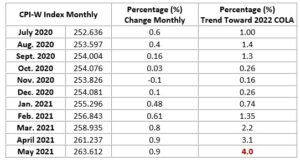The 2022 cost-of-living adjustment (COLA) is looking to be much more than in previous years for Federal Employees Retirement System (FERS) and Civil Service Retirement System (CSRS) annuities and Social Security benefits.
The Senior Citizens League (TSCL), a nonpartisan senior group, recently released a 2022 COLA estimate hinting at a 4.7% increase to benefits starting as soon as next January.
While this number is not out of the ballpark, by tracking the current trend of the cost of living increase for 2022 based on data from the Bureau of Labor Statistics, another number has emerged slightly below the TSCL prediction.
The Consumer Price Index for Urban Wage Earners and Clerical Workers (CPI-W) increased 5.6 percent over the last 12 months to an index level of 263.612 (1982-84=100). During the month of May, the index rose 0.9 percent prior to seasonal adjustment.
So what will the COLA for 2022 be? The chart below demonstrates the current trend toward determining the 2022 COLA for Social Security and the CSRS / FERS federal retirement programs.
(FERS / CSRS / Social Security)

So how exactly is each year’s COLA determined? By looking at the change in the CPI-W from year to year, and is based on the average of the third-quarter months of July, August and September. The average CPI-W for the third quarter of 2020 was 253.412.
The amount of a COLA is created by the percent change in the base quarter price index from the previous year to the year in which the COLA is to become effective (the final number is adjusted to nearest 1/10 of 1 percent).
With that being said, and as of May 2021, the trend toward a 2022 COLA is:
(263.612 – 253.412) / 253.412 x 100 = 4.025 (adjusted to the nearest 1/10 of 1 percent = 4.0%)
The official 2022 COLA will be released in October by the Social Security Administration (SSA). The SSA will calculate the percent change between average prices in the third quarter of the current year (ending on Sept. 30) with the third quarter of the previous year.
Higher COLA would be wonderful for retirees. A recent study from TSCL revealed that consumer price data through March 2021 indicated that Social Security benefits have lost 30 percent of their buying power and “that loss of buying power could grow deeper in 2021, should the current inflationary trends continue,” according to Mary Johnson, a Social Security policy analyst for TSCL.
“While the lack of inflation in 2020 did improve the buying power of Social Security benefits by 2 percentage points through the month of January 2021 — from a loss in buying power of 30 percent to a loss of 28 percent — that improvement was completely wiped out by soaring inflation in February and March of this year,” Johnson said.
If this figure at 4.0% continues to rise, it could be the highest COLA since 2009 when the increase received by beneficiaries was at 5.8%.


